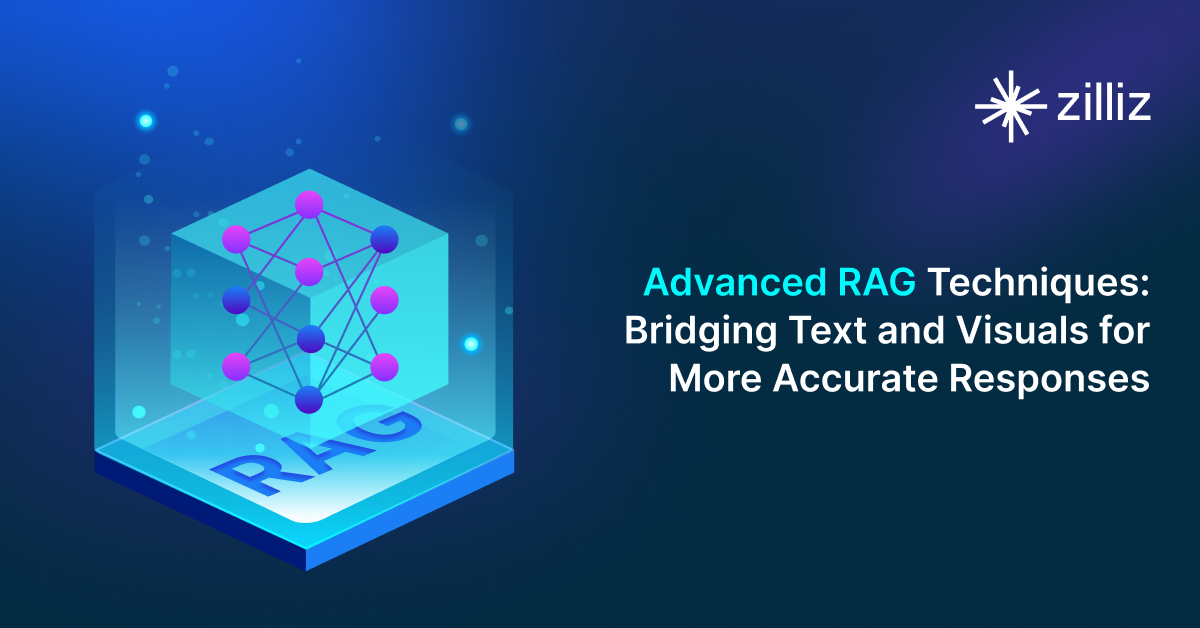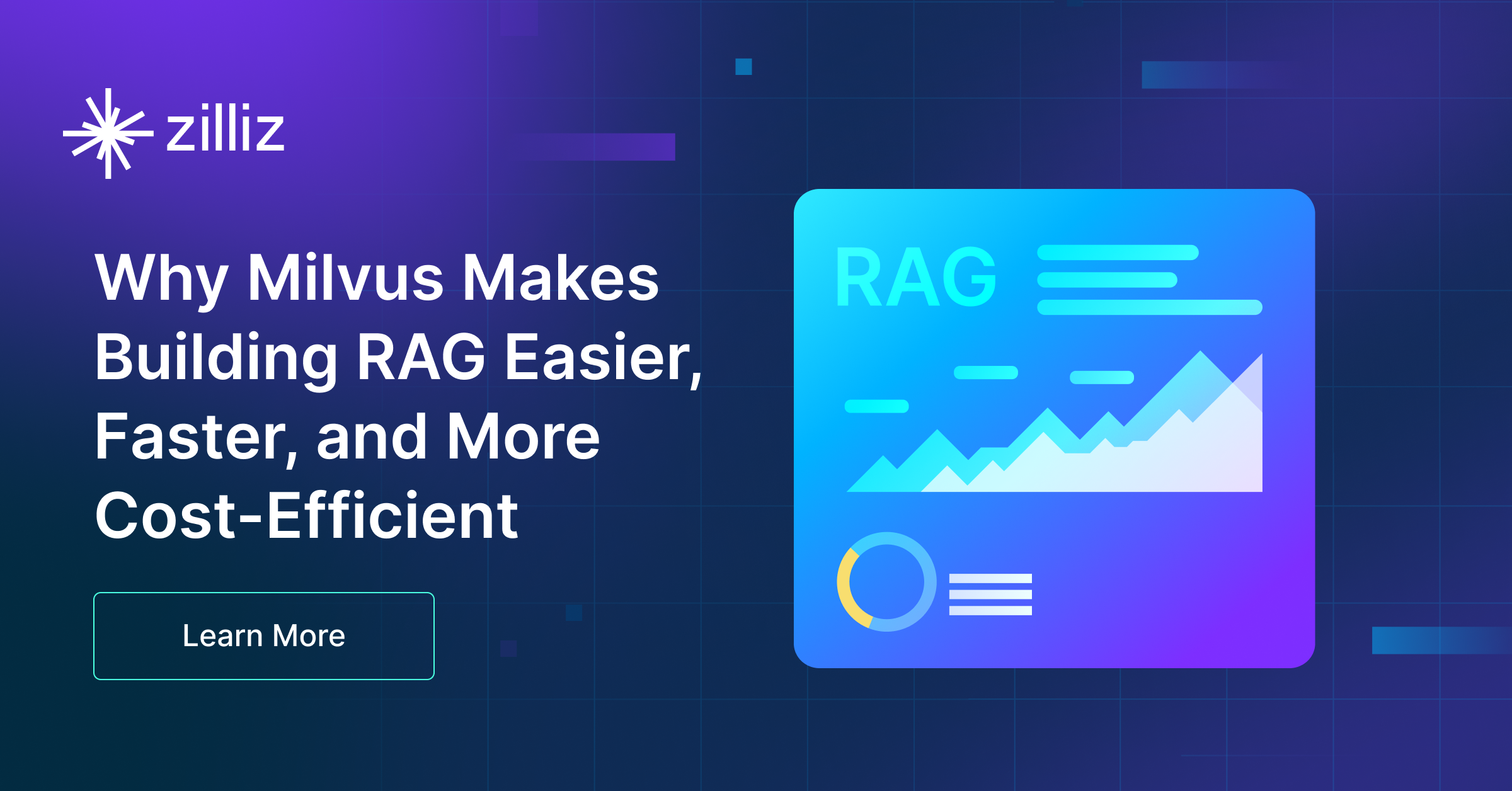Build RAG Chatbot with Haystack, Milvus, Google Vertex AI Gemini 2.0 Flash, and jina-clip-v2
Introduction to RAG
Retrieval-Augmented Generation (RAG) is a game-changer for GenAI applications, especially in conversational AI. It combines the power of pre-trained large language models (LLMs) like OpenAI’s GPT with external knowledge sources stored in vector databases such as Milvus and Zilliz Cloud, allowing for more accurate, contextually relevant, and up-to-date response generation. A RAG pipeline usually consists of four basic components: a vector database, an embedding model, an LLM, and a framework.
Key Components We'll Use for This RAG Chatbot
This tutorial shows you how to build a simple RAG chatbot in Python using the following components:
- Haystack: An open-source Python framework designed for building production-ready NLP applications, particularly question answering and semantic search systems. Haystack excels at retrieving information from large document collections through its modular architecture that combines retrieval and reader components. Ideal for developers creating search applications, chatbots, and knowledge management systems that require efficient document processing and accurate information extraction from unstructured text.
- Milvus: An open-source vector database optimized to store, index, and search large-scale vector embeddings efficiently, perfect for use cases like RAG, semantic search, and recommender systems. If you hate to manage your own infrastructure, we recommend using Zilliz Cloud, which is a fully managed vector database service built on Milvus and offers a free tier supporting up to 1 million vectors.
- Google Vertex AI Gemini 2.0 Flash: A lightweight, high-speed AI model optimized for rapid inference and cost-effective scalability. It excels in real-time applications requiring low latency, such as chatbots, summarization, and data processing, balancing performance with efficiency for high-volume enterprise workloads on Google Cloud.
- Jina-CLIP-V2: A multimodal AI model designed to seamlessly connect text and visual data, excelling in cross-modal retrieval tasks. Strengths include high accuracy in image-text matching, multilingual support, and scalable architecture. Ideal for semantic image search, content moderation, and personalized recommendations in e-commerce or media platforms.
By the end of this tutorial, you’ll have a functional chatbot capable of answering questions based on a custom knowledge base.
Note: Since we may use proprietary models in our tutorials, make sure you have the required API key beforehand.
Step 1: Install and Set Up Haystack
import os
import requests
from haystack import Pipeline
from haystack.components.converters import MarkdownToDocument
from haystack.components.preprocessors import DocumentSplitter
from haystack.components.writers import DocumentWriter
Step 2: Install and Set Up Google Vertex AI Gemini 2.0 Flash
Using theVertexAIGeminiGenerator with Haystack requires authentication using Google Cloud Application Default Credentials (ADCs). This means your application must be set up with credentials that allow it to access Google Cloud services. If you're not sure how to configure ADCs, check the official Google documentation for setup instructions.
It's important to use a Google Cloud account that has the right permissions to access a project with Google Vertex AI endpoints. Without proper access, the generator won’t work as expected.
To find your project ID, you can either look it up in the Google Cloud Console under the resource manager or run the following command in your terminal.
Now let's install and set up this model.
pip install google-vertex-haystack
from haystack_integrations.components.generators.google_vertex import VertexAIGeminiGenerator
generator = VertexAIGeminiGenerator(model="gemini-2.0-flash-001")
Step 3: Install and Set Up jina-clip-v2
pip install jina-haystack
from haystack_integrations.components.embedders.jina import JinaTextEmbedder
from haystack_integrations.components.embedders.jina import JinaDocumentEmbedder
text_embedder = JinaTextEmbedder(api_key=Secret.from_token("<your-api-key>"), model="jina-clip-v2")
document_embedder = JinaDocumentEmbedder(api_key=Secret.from_token("<your-api-key>"), model="jina-clip-v2")
Step 4: Install and Set Up Milvus
pip install --upgrade pymilvus milvus-haystack
from milvus_haystack import MilvusDocumentStore
from milvus_haystack.milvus_embedding_retriever import MilvusEmbeddingRetriever
document_store = MilvusDocumentStore(connection_args={"uri": "./milvus.db"}, drop_old=True,)
retriever = MilvusEmbeddingRetriever(document_store=document_store, top_k=3)
Step 5: Build a RAG Chatbot
Now that you’ve set up all components, let’s start to build a simple chatbot. We’ll use the Milvus introduction doc as a private knowledge base. You can replace it your own dataset to customize your RAG chatbot.
url = 'https://raw.githubusercontent.com/milvus-io/milvus-docs/refs/heads/v2.5.x/site/en/about/overview.md'
example_file = 'example_file.md'
response = requests.get(url)
with open(example_file, 'wb') as f:
f.write(response.content)
file_paths = [example_file] # You can replace it with your own file paths.
indexing_pipeline = Pipeline()
indexing_pipeline.add_component("converter", MarkdownToDocument())
indexing_pipeline.add_component("splitter", DocumentSplitter(split_by="sentence", split_length=2))
indexing_pipeline.add_component("embedder", document_embedder)
indexing_pipeline.add_component("writer", DocumentWriter(document_store))
indexing_pipeline.connect("converter", "splitter")
indexing_pipeline.connect("splitter", "embedder")
indexing_pipeline.connect("embedder", "writer")
indexing_pipeline.run({"converter": {"sources": file_paths}})
# print("Number of documents:", document_store.count_documents())
question = "What is Milvus?" # You can replace it with your own question.
retrieval_pipeline = Pipeline()
retrieval_pipeline.add_component("embedder", text_embedder)
retrieval_pipeline.add_component("retriever", retriever)
retrieval_pipeline.connect("embedder", "retriever")
retrieval_results = retrieval_pipeline.run({"embedder": {"text": question}})
# for doc in retrieval_results["retriever"]["documents"]:
# print(doc.content)
# print("-" * 10)
from haystack.utils import Secret
from haystack.components.builders import PromptBuilder
retriever = MilvusEmbeddingRetriever(document_store=document_store, top_k=3)
text_embedder = JinaTextEmbedder(api_key=Secret.from_token("<your-api-key>"), model="jina-clip-v2")
prompt_template = """Answer the following query based on the provided context. If the context does
not include an answer, reply with 'I don't know'.\n
Query: {{query}}
Documents:
{% for doc in documents %}
{{ doc.content }}
{% endfor %}
Answer:
"""
rag_pipeline = Pipeline()
rag_pipeline.add_component("text_embedder", text_embedder)
rag_pipeline.add_component("retriever", retriever)
rag_pipeline.add_component("prompt_builder", PromptBuilder(template=prompt_template))
rag_pipeline.add_component("generator", generator)
rag_pipeline.connect("text_embedder.embedding", "retriever.query_embedding")
rag_pipeline.connect("retriever.documents", "prompt_builder.documents")
rag_pipeline.connect("prompt_builder", "generator")
results = rag_pipeline.run({"text_embedder": {"text": question}, "prompt_builder": {"query": question},})
print('RAG answer:\n', results["generator"]["replies"][0])
Optimization Tips
As you build your RAG system, optimization is key to ensuring peak performance and efficiency. While setting up the components is an essential first step, fine-tuning each one will help you create a solution that works even better and scales seamlessly. In this section, we’ll share some practical tips for optimizing all these components, giving you the edge to build smarter, faster, and more responsive RAG applications.
Haystack optimization tips
To optimize Haystack in a RAG setup, ensure you use an efficient retriever like FAISS or Milvus for scalable and fast similarity searches. Fine-tune your document store settings, such as indexing strategies and storage backends, to balance speed and accuracy. Use batch processing for embedding generation to reduce latency and optimize API calls. Leverage Haystack's pipeline caching to avoid redundant computations, especially for frequently queried documents. Tune your reader model by selecting a lightweight yet accurate transformer-based model like DistilBERT to speed up response times. Implement query rewriting or filtering techniques to enhance retrieval quality, ensuring the most relevant documents are retrieved for generation. Finally, monitor system performance with Haystack’s built-in evaluation tools to iteratively refine your setup based on real-world query performance.
Milvus optimization tips
Milvus serves as a highly efficient vector database, critical for retrieval tasks in a RAG system. To optimize its performance, ensure that indexes are properly built to balance speed and accuracy; consider utilizing HNSW (Hierarchical Navigable Small World) for efficient nearest neighbor search where response time is crucial. Partitioning data based on usage patterns can enhance query performance and reduce load times, enabling better scalability. Regularly monitor and adjust cache settings based on query frequency to avoid latency during data retrieval. Employ batch processing for vector insertions, which can minimize database lock contention and enhance overall throughput. Additionally, fine-tune the model parameters by experimenting with the dimensionality of the vectors; higher dimensions can improve retrieval accuracy but may increase search time, necessitating a balance tailored to your specific use case and hardware infrastructure.
Google Vertex AI Gemini 2.0 Flash optimization tips
To optimize Gemini 2.0 Flash in RAG, balance chunk size for retrieved documents—smaller chunks (200-400 tokens) improve precision, while larger ones preserve context. Use preprocessing to clean text, remove noise, and add metadata (e.g., timestamps) for relevance scoring. Adjust model parameters: lower temperature (0.2-0.5) for factual outputs, and limit max_output_tokens to reduce latency. Batch process embeddings to cut API calls. Cache frequent queries and responses. Fine-tune with domain-specific data if available. Monitor latency and cost via Vertex AI’s tools, and use asynchronous calls for non-blocking operations.
Jina-CLIP-v2 optimization tips
To optimize Jina-CLIP-v2 in a RAG setup, preprocess inputs by cleaning text, normalizing formats, and truncating overly long documents to reduce noise. Use batch inference for embeddings to leverage GPU parallelism, and ensure model weights are quantized or pruned for faster inference. Cache frequently accessed embeddings to avoid redundant computations. Fine-tune the model on domain-specific data to improve retrieval relevance. Pair with efficient vector indexes (e.g., FAISS) for low-latency similarity searches, and monitor embedding quality via recall metrics to balance speed and accuracy. Regularly update the index with fresh data.
By implementing these tips across your components, you'll be able to enhance the performance and functionality of your RAG system, ensuring it’s optimized for both speed and accuracy. Keep testing, iterating, and refining your setup to stay ahead in the ever-evolving world of AI development.
RAG Cost Calculator: A Free Tool to Calculate Your Cost in Seconds
Estimating the cost of a Retrieval-Augmented Generation (RAG) pipeline involves analyzing expenses across vector storage, compute resources, and API usage. Key cost drivers include vector database queries, embedding generation, and LLM inference.
RAG Cost Calculator is a free tool that quickly estimates the cost of building a RAG pipeline, including chunking, embedding, vector storage/search, and LLM generation. It also helps you identify cost-saving opportunities and achieve up to 10x cost reduction on vector databases with the serverless option.
 Calculate your RAG cost
Calculate your RAG cost
What Have You Learned?
By diving into this tutorial, you’ve unlocked the power of integrating cutting-edge tools to build a robust RAG system from the ground up! You learned how Haystack acts as the flexible framework that orchestrates the entire pipeline, simplifying complex workflows so you can focus on creativity rather than configuration. Pairing it with Milvus, the high-performance vector database, you saw firsthand how to store and retrieve embeddings at lightning speed, even with massive datasets. Then came the magic of Google Vertex AI Gemini 2.0 Flash—a lightweight yet powerful LLM that delivers rapid, accurate responses while keeping costs low—and jina-clip-v2, the versatile embedding model that transforms text and images into rich numerical representations. Together, these tools form a seamless RAG pipeline: ingesting data, generating embeddings, retrieving context, and synthesizing answers that feel almost human. You even picked up pro tips for optimizing performance, like fine-tuning chunk sizes and balancing latency with accuracy, plus how to use the free RAG cost calculator to budget your projects smartly.
Now, imagine what’s next! You’ve got all the pieces to build AI applications that answer questions, analyze multimedia, or even power personalized recommendations. Whether you’re prototyping a chatbot or scaling an enterprise solution, these tools are your playground. Don’t stop here—experiment with hybrid search in Milvus, tweak prompts in Gemini for sharper outputs, or explore jina-clip-v2’s multimodal magic. The world of RAG is evolving fast, and you’re equipped to lead the charge. So fire up your IDE, embrace the trial-and-error joy, and start creating. Your next breakthrough is just a few lines of code away—let’s build something amazing! 🚀
Further Resources
🌟 In addition to this RAG tutorial, unleash your full potential with these incredible resources to level up your RAG skills.
- How to Build a Multimodal RAG | Documentation
- How to Enhance the Performance of Your RAG Pipeline
- Graph RAG with Milvus | Documentation
- How to Evaluate RAG Applications - Zilliz Learn
- Generative AI Resource Hub | Zilliz
We'd Love to Hear What You Think!
We’d love to hear your thoughts! 🌟 Leave your questions or comments below or join our vibrant Milvus Discord community to share your experiences, ask questions, or connect with thousands of AI enthusiasts. Your journey matters to us!
If you like this tutorial, show your support by giving our Milvus GitHub repo a star ⭐—it means the world to us and inspires us to keep creating! 💖
- Introduction to RAG
- Key Components We'll Use for This RAG Chatbot
- Step 1: Install and Set Up Haystack
- Step 2: Install and Set Up Google Vertex AI Gemini 2.0 Flash
- Step 3: Install and Set Up jina-clip-v2
- Step 4: Install and Set Up Milvus
- Step 5: Build a RAG Chatbot
- Optimization Tips
- RAG Cost Calculator: A Free Tool to Calculate Your Cost in Seconds
- What Have You Learned?
- Further Resources
- We'd Love to Hear What You Think!
Content
Vector Database at Scale
Zilliz Cloud is a fully-managed vector database built for scale, perfect for your RAG apps.
Try Zilliz Cloud for Free


